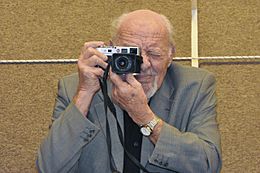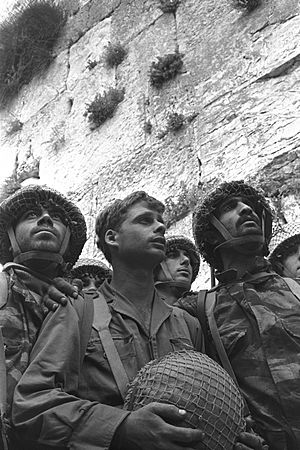David Rubinger facts for kids
Quick facts for kids
David Rubinger
|
|
|---|---|

David Rubinger with his Leica Camera
|
|
| Born | 29 June 1924 Vienna, Austria
|
| Died | 2 March 2017 (aged 92) |
| Nationality | Israeli |
| Known for | photojournalism |
|
Notable work
|
Paratroopers at the Western Wall |
| Movement | Israeli art |
| Awards | Israel Prize in Communications, 1997 |
David Rubinger (born June 29, 1924 – died March 2, 2017) was a very famous Israeli photographer. He was known for taking pictures for news stories, a job called photojournalism. His most famous photo shows three Israeli paratroopers at the Western Wall. This picture became a powerful symbol of the Six-Day War. Shimon Peres, a former Israeli President, once called Rubinger "the photographer of the nation."
Contents
David Rubinger's Life Story
David Rubinger was born in Vienna, Austria. He was an only child. When he was in high school, Nazi Germany took over Austria. This event was called the Anschluss. David managed to escape to Mandatory Palestine (which is now Israel). He traveled through Italy to get there.
He settled in a Jordan Valley kibbutz, a type of community. His father had already moved to England. Sadly, David's mother died during the Holocaust.
Serving in World War II
During the Second World War, David joined the Jewish Brigade. This was a group of Jewish soldiers in the British Army. He served in North Africa and Europe. While on a break in Paris, a friend gave him a camera. He soon discovered he loved taking pictures. His first professional photo was of Jewish young people. They were climbing a British tank to celebrate the plan to create Israel.
Family Life
After the war, David visited his father in England. He learned that he had other relatives in Germany. There, he met his cousin Anni. She and her mother had survived the Holocaust. David offered to marry Anni so she could move to Palestine. Their marriage lasted for over 50 years. They had two children together. David took care of Anni when she was sick with cancer. After Anni passed away, David met Ziona Spivak. They were together for two and a half years.
David Rubinger died on March 2, 2017. He was 92 years old.
David Rubinger's Photography Career
When David returned to Mandatory Palestine in 1946, he started his own photography business in Jerusalem. He soon began working as a photojournalist. In 1951, he got a job at HaOlam HaZeh magazine. He worked there for two years. After that, he joined Yedioth Ahronoth and then The Jerusalem Post.
Working for Time–Life
His big break came in 1954. He was asked to take photos for Time–Life magazine. He ended up working for them for more than 50 years. His first picture published internationally was of a nun. She was holding dentures that had fallen from a hospital window. The dentures landed in Jordanian territory. The nun had to negotiate a lot to get them back.
As the main photographer for Time–Life in the region, David covered all of Israel's wars. He had special access to government leaders. He was the only photographer allowed in the Knesset (Israel's parliament) cafeteria. Because he was always around, leaders got used to him. This allowed him to take very natural and memorable photos. For example, he captured Golda Meir feeding her granddaughter. He also took quiet pictures of Yitzhak and Leah Rabin.
The Famous Western Wall Photo
Rubinger's most famous photograph shows paratroopers at the Western Wall. He took it soon after Israeli forces took back the area in the Six-Day War. The photo is taken from a low angle. It shows the faces of Zion Karasenti, Yitzhak Yifat, and Haim Oshri. They are looking away from the wall, and Yifat holds his helmet. An Israeli writer, Yossi Klein Halevi, called it "the most beloved Jewish photographic image of our time."
How the Photo Was Taken
Before taking the picture, Rubinger was in el-Arish in the Sinai Peninsula. He heard a rumor that something big was happening in Jerusalem. He quickly got on a helicopter that was taking wounded soldiers to Beersheba. He didn't know where it was going at first. His car happened to be there, so he drove the rest of the way. At one point, he was so tired he asked a hitchhiking soldier to drive.
He arrived in the Old City and quickly visited his family. Then he went to the wall. The space in front of the wall was very narrow. So, he lay down to get a good shot of the wall itself. Just then, the paratroopers walked by. He quickly took several pictures of them.
About twenty minutes later, IDF Chief Rabbi Shlomo Goren arrived. He had a shofar (a ram's horn) and a Torah scroll. Soldiers lifted Goren onto their shoulders. It was a very emotional moment. Rubinger actually preferred his photo of that scene. But his wife Anni told him the picture of the three soldiers was better.
Sharing the Iconic Image
As part of his agreement with the Israeli Army, David gave his photo negatives to the government. They then shared the photo widely for a very small fee. Many people also copied the photo without permission. Even though Rubinger was upset about his work being copied, this wide sharing made the photo incredibly famous.
The image is so powerful that it has become a symbol of Israel. In 2001, an Israeli Supreme Court Justice said that the photo had "become the property of the entire nation."
Awards and Special Recognition
David Rubinger received the Israel Prize in communications in 1997. This was the first year the award was given in that category. He was the first photographer to get the Israel Prize. The photography category itself was not created until 2000.
On March 5, 2017, the Israeli newspaper Yedioth Ahronoth published a special 21-page photo section. It showed many of David's best pictures from his career. The section was called "The Man Who Was There." The cover said: "There's no Israeli leader he didn't photograph or historic event where he wasn't present. David Rubinger, who passed away last week, is the photographer of our life here in Israel."
See also
- Visual arts in Israel
- List of Israel Prize recipients
Images for kids



